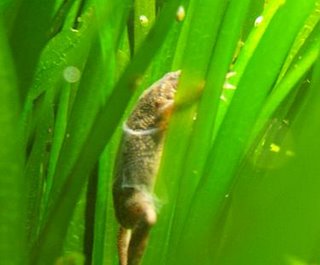Monday, October 23, 2006
i just watched my frog do this!!! ewwww!
it's like National Geographic Explorer on my desk. LOL.
i own two African Clawed Frogs (very tiny aquatic frogs), they are one of the few things i can keep in the tank with my Beta (Siamese fighting fish). They reside in a tank on top of my desk and i watch them swim and do their "frog ballets" to relax in between things. they are quite amusing in their antics.
... he was acting all freaky, jerking around and being extremely spastic. i had just moved him (and his mate) to a larger tank and thought maybe he was sick. he kept acting freakier, and i thought for a few minutes he was dying ....suddenly he wriggled out of his skin in front of my eyes!!!!
my iguana sheds a few times a year, but i never knew frogs shed. it was *weird* to watch. no, he didn't eat the leftover skin. had i seen that, i would have tossed my cookies LOL

African Clawed Frogs shed their skin. When they begin shedding you may notice them swimming around with clear-white colored film hanging from their mouths. Frogs have very special skin! They don't just wear it, they drink and breathe through it.
Frogs don't usually swallow water like we do. Instead they absorb most of the moisture they need through their skin.
Not only that, but frogs also rely on getting extra oxygen (in addition to what they get from their lungs) from the water by absorbing it through their skin. Because frogs get oxygen through their skin when it's moist, they need to take care of their skin or they might suffocate. Sometimes you'll find frogs that are slimy. This is because the frog skin secretes a mucus that helps keep it moist. Even with the slimy skin, these frogs need to stay near water. Toads on the other hand have tougher skin that doesn't dry out as fast, so they can live farther from water than most frogs. In addition to jumping in water, frogs and toads can get moisture from dew, or they can burrow underground into moist soil.
Frogs shed their skin regularly to keep it healthy. Some frogs shed their skin weekly, others as often as every day! This looks pretty yucky...they start to twist and turn and act like they have the hiccups. They do this to stretch themselves out of their old skin! Finally, the frog pulls the skin off over it's head, like a sweater, and then (this is gross) the frog EATS IT!!!! (EEEEEWWW!)
i own two African Clawed Frogs (very tiny aquatic frogs), they are one of the few things i can keep in the tank with my Beta (Siamese fighting fish). They reside in a tank on top of my desk and i watch them swim and do their "frog ballets" to relax in between things. they are quite amusing in their antics.
... he was acting all freaky, jerking around and being extremely spastic. i had just moved him (and his mate) to a larger tank and thought maybe he was sick. he kept acting freakier, and i thought for a few minutes he was dying ....suddenly he wriggled out of his skin in front of my eyes!!!!
my iguana sheds a few times a year, but i never knew frogs shed. it was *weird* to watch. no, he didn't eat the leftover skin. had i seen that, i would have tossed my cookies LOL

African Clawed Frogs shed their skin. When they begin shedding you may notice them swimming around with clear-white colored film hanging from their mouths. Frogs have very special skin! They don't just wear it, they drink and breathe through it.
Frogs don't usually swallow water like we do. Instead they absorb most of the moisture they need through their skin.
Not only that, but frogs also rely on getting extra oxygen (in addition to what they get from their lungs) from the water by absorbing it through their skin. Because frogs get oxygen through their skin when it's moist, they need to take care of their skin or they might suffocate. Sometimes you'll find frogs that are slimy. This is because the frog skin secretes a mucus that helps keep it moist. Even with the slimy skin, these frogs need to stay near water. Toads on the other hand have tougher skin that doesn't dry out as fast, so they can live farther from water than most frogs. In addition to jumping in water, frogs and toads can get moisture from dew, or they can burrow underground into moist soil.
Frogs shed their skin regularly to keep it healthy. Some frogs shed their skin weekly, others as often as every day! This looks pretty yucky...they start to twist and turn and act like they have the hiccups. They do this to stretch themselves out of their old skin! Finally, the frog pulls the skin off over it's head, like a sweater, and then (this is gross) the frog EATS IT!!!! (EEEEEWWW!)
Tuesday, July 11, 2006
Video: Kid sneaks up on Elephant Seal
Sunday, June 25, 2006
Cool Doggie!
Saturday, June 24, 2006
Help put an end to whaling!

Target: International Whaling Commission
Current Signatures: 176288
Signature Goal: 1,000,000
Welcome to Whales Revenge, an ambitious campaign to gather 1 million signatures for a petition to stop whaling.
Every year thousands of precious mammals are slaughtered in the name of so-called 'scientific research'.
Add your voice by signing this campaign then forwarding it everyone you know. Please help us stop the killing.
www.whalesrevenge.com
Friday, June 23, 2006
Stihl advertisement
Thursday, June 22, 2006
Disaster Preparation for Pets
GET READY
by Gina Spadafori
The first time I wrote about disaster preparation for pets, some 20 years ago, there wasn't much to write about. I called a disaster-response official and he seemed rather puzzled at the questions I wasn't asking. Pets? Who cares?
Finally, he told me people should open big bags of pet food, fill the bathtub with water and leave their pets behind. His whole attitude: What's the big fuss? They're just pets!
I'll guarantee you no disaster-response expert would dare voice such an opinion today. And it's not just because they recognize that animals are worth saving -- because it's possible many still don't. What has become apparent over the years is that if no plans are made for pets, people won't leave their homes. And when people won't leave, that puts everyone in greater peril.
But even though it's true that government on all levels has a greater interest in helping people and pets in time of disaster, it's still pretty much up to each of us to be ready to care for our animal companions. With another hurricane season upon us -- and no community immune from the threat of disaster -- it's a good time to review your plans and your pets' place in them.
Start your preparations with something you've probably already taken care of: Make sure your pets have ID.
Most animals will survive a disaster, but many never see their families again because there's no way to determine which pet belongs to which family if the animals go missing, a common occurrence even under normal circumstances. That's why dogs and cats should always wear a collar and identification tags.
Once your pet has up-to-date ID, it's time to collect some equipment to help you cope in case of an emergency. A big storage bin with a lid and handles is an ideal place to keep everything you need together and at hand.
Keep several days' worth of drinking water and pet food as well as any necessary medicines, rotating the stock regularly. For canned goods, don't forget to pack a can opener and a spoon. Lay in a supply of empty plastic bags, along with paper towels, both for cleaning up messes and for sealing them away until they can be safely tossed.
For cats, pack a bag of litter and some disposable litter trays.
Even normally docile pets can behave in uncharacteristic ways when stressed by an emergency, which makes restraints essential for the safety of pets and people alike. For dogs, leashes should always be at hand.
Shipping crates are probably the least-thought-of pieces of emergency equipment for pets, but are among the most important. Sturdy crates keep pets of all kinds safe while increasing housing options. Crated pets may be allowed in hotel rooms that are normally off-limits to pets, or can be left in a pinch with veterinarians or shelters that are already full, since the animals come with rooms of their own.
Final item of restraint for dogs and cats: a soft muzzle, because frightened or injured pets are more likely to bite. And don't forget to put first-aid supplies in your disaster kit, along with a book on how to treat pet injuries.
You may never have to pull out your disaster kit, but it's always good to be prepared.
Back to the official response: The U.S. Department of Homeland Security, in cooperation with the American Kennel Club, the American Society for the Prevention of Cruelty to Animals, the American Veterinary Medical Association and the Humane Society of the United States, has put together a free emergency preparedness brochure for pet lovers. Visit www.ready.gov or call 1-800-BE-READY for more information.
by Gina Spadafori
The first time I wrote about disaster preparation for pets, some 20 years ago, there wasn't much to write about. I called a disaster-response official and he seemed rather puzzled at the questions I wasn't asking. Pets? Who cares?
Finally, he told me people should open big bags of pet food, fill the bathtub with water and leave their pets behind. His whole attitude: What's the big fuss? They're just pets!
I'll guarantee you no disaster-response expert would dare voice such an opinion today. And it's not just because they recognize that animals are worth saving -- because it's possible many still don't. What has become apparent over the years is that if no plans are made for pets, people won't leave their homes. And when people won't leave, that puts everyone in greater peril.
But even though it's true that government on all levels has a greater interest in helping people and pets in time of disaster, it's still pretty much up to each of us to be ready to care for our animal companions. With another hurricane season upon us -- and no community immune from the threat of disaster -- it's a good time to review your plans and your pets' place in them.
Start your preparations with something you've probably already taken care of: Make sure your pets have ID.
Most animals will survive a disaster, but many never see their families again because there's no way to determine which pet belongs to which family if the animals go missing, a common occurrence even under normal circumstances. That's why dogs and cats should always wear a collar and identification tags.
Once your pet has up-to-date ID, it's time to collect some equipment to help you cope in case of an emergency. A big storage bin with a lid and handles is an ideal place to keep everything you need together and at hand.
Keep several days' worth of drinking water and pet food as well as any necessary medicines, rotating the stock regularly. For canned goods, don't forget to pack a can opener and a spoon. Lay in a supply of empty plastic bags, along with paper towels, both for cleaning up messes and for sealing them away until they can be safely tossed.
For cats, pack a bag of litter and some disposable litter trays.
Even normally docile pets can behave in uncharacteristic ways when stressed by an emergency, which makes restraints essential for the safety of pets and people alike. For dogs, leashes should always be at hand.
Shipping crates are probably the least-thought-of pieces of emergency equipment for pets, but are among the most important. Sturdy crates keep pets of all kinds safe while increasing housing options. Crated pets may be allowed in hotel rooms that are normally off-limits to pets, or can be left in a pinch with veterinarians or shelters that are already full, since the animals come with rooms of their own.
Final item of restraint for dogs and cats: a soft muzzle, because frightened or injured pets are more likely to bite. And don't forget to put first-aid supplies in your disaster kit, along with a book on how to treat pet injuries.
You may never have to pull out your disaster kit, but it's always good to be prepared.
Back to the official response: The U.S. Department of Homeland Security, in cooperation with the American Kennel Club, the American Society for the Prevention of Cruelty to Animals, the American Veterinary Medical Association and the Humane Society of the United States, has put together a free emergency preparedness brochure for pet lovers. Visit www.ready.gov or call 1-800-BE-READY for more information.
Wednesday, June 21, 2006
Doggles
Tuesday, June 20, 2006
Wild Captivity of Whales & Dolphins


Please visit the ACS at: http://www.acsonline.org/education/index.html
Whales and dolphins are still being captured around the world for display in marine parks, hotels and even small traveling circuses. While the large, well-funded marine parks such as Sea World adhere to strict (especially in the United States) regulations, many others around the world do not. The unfortunate animals who are captive in these poorly regulated circumstances are often condemned to a short, miserable life.
The most popular species for captivity are dolphins and killer whales, who have highly complex societies and very tight family ties, not only does captivity place a wide-ranging (often over 100 miles a day) animal into a small, unnatural tank, but also a family and society are broken apart.
For many years, for example, marine parks stated that killer whales lived about the same number of years in captivity as they do in the wild. However, thanks to long-term research, especially off the west coast of North America, scientists believe that killer whales can live to 80+ years in the wild. If a captive orca reaches 30, it is extremely rare. Most die within a few years of their capture.
Capturing cetaceans for below standard facilities, and swim-with programs at hotels, is pure exploitation for profit, with no attempt to tout education as the rationale. Many of these animals (if they survive the capture) are kept in unbelievable circumstances, in tiny tanks, with poor water and inadequate food and veterinary care. Swim-with programs at hotels are all about profit and pleasing humans, with little thought given to the social and health needs of the dolphins.
Thursday, June 01, 2006
Bat Dog
Wednesday, May 17, 2006
Greyhound Adoption Video
Mid-South Greyhound Adoption Option is one resource for people to adopt retired racing greyhounds.
Love this video - beautiful dogs for adoption! If you love dogs, this will put a smile on your face, seeing what they are doing to help retired racers find homes. Very nice facility, too.
Love this video - beautiful dogs for adoption! If you love dogs, this will put a smile on your face, seeing what they are doing to help retired racers find homes. Very nice facility, too.




